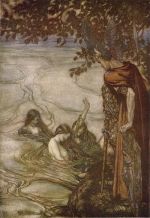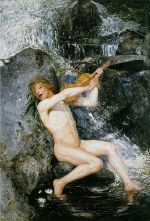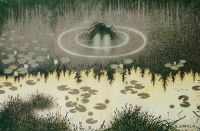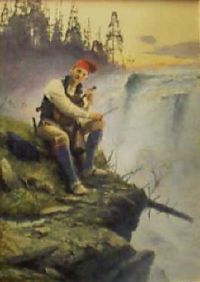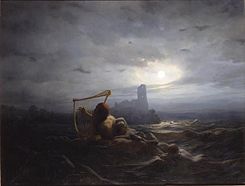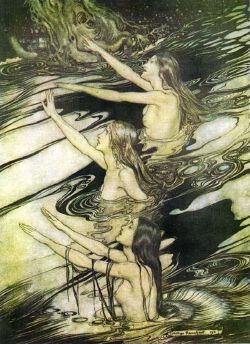Nix
The Neck (English) or the Nix/Nixe (German) refer to shapeshifting water spirits who usually appear in human form. The spirit has appeared in the myths and legends of all Germanic peoples of Europe.[1]
Their sex, bynames and various animal-like transformations vary geographically. The German Nix and his Scandinavian counterparts are males, whereas the Geman Nixe or Nixie is a female river mermaid.[1]
Names and etymology
Common bynames are the Swedish Strömkarlen and the Norwegian Fossegrim.[2] Since the Scandinavian version can transform himself into a horse-like kelpie, he is also called Bäckahästen (the "brook horse"). In Germany where they mainly appear as female, they are also called Rhine maidens.
Näcken, Nøkken
The Scandinavian näcken, nøkken, strömkarlen,[3] Grim or Fosse-Grim were male water spirits who played enchanted songs on the violin, luring women and children to drown in lakes or streams. However, not all of these spirits were necessarily malevolent; in fact, many stories exist that indicate at the very least that Fossegrim were entirely harmless to their audience and attracted not only women and children, but men as well with their sweet songs. Stories also exist wherein the Fossegrim agreed to live with a human who had fallen in love with him, but many of these stories ended with the Fossegrim returning to his home, usually a nearby waterfall or brook. Fossegrim are said to grow despondent if they do not have free, regular contact with a water source.
If properly approached, he will teach a musician to play so adeptly "that the trees dance and waterfalls stop at his music," [1]
It is difficult to describe the actual appearance of the nix, as one of his central attributes was thought to be shapeshifting. Perhaps he did not have any true shape. He could show himself as a man playing the violin in brooks and waterfalls (though often imagined as fair and naked today, in actual folklore he was more frequently wearing more or less elegant clothing) but also could appear to be treasure or various floating objects or as an animal — most commonly in the form of a "brook horse" (see below). The modern Scandinavian names are derived from an Old Norse nykr, meaning "river horse." Thus, likely the brook horse preceded the personification of the nix as the "man in the rapids." Fossegrim and derivatives were almost always portrayed as especially beautiful young men, whose clothing (or lack thereof) varied widely from story to story.
The enthralling music of the nix was most dangerous to women and children, especially pregnant women and unbaptised children. He was thought to be most active during Midsummer's Night, on Christmas Eve and on Thursdays. However, these superstitions do not necessarily relate to all the versions listed here, and many if not all of them were developed after the Christianizing of the Northern countries, as were similar stories of faeries and other entities in other areas.
When malicious nix attempted to carry off people, they could be defeated by calling their name; this, in fact, would be the death of them.[4]
If you brought the nix a treat of three drops of blood, a black animal, some brännvin (Scandinavian vodka) or snus (wet snuff) dropped into the water, he would teach you his enchanting form of music.
The nix was also an omen for drowning accidents. He would scream at a particular spot in a lake or river, in a way reminiscent of the loon, and on that spot a fatality would later take place.
Bäckahästen
Bäckahästen (translated as the brook horse) is a mythological horse in Scandinavian folklore. It has a close parallel in the Scottish kelpie.
It was often described as a majestic white horse that would appear near rivers, particularly during foggy weather. Anyone who climbed onto its back would not be able to get off again. The horse would then jump into the river, drowning the rider. The brook horse could also be harnessed and made to plough, either because it was trying to trick a person or because the person had tricked the horse into it.
Germany
The German Nix and Nixe (and Nixie) are types of river merman and mermaid who may lure men to drown, like the Skandavian type, akin to the Celtic Melusine and similar to the Greek Siren. The German epic Nibelungenlied mentions the Nix in connection with the Danube, as early as 1180 to 1210.
Nixes in folklore became water sprites[5] who try to lure people into the water. The males can assume many different shapes, including that of a human, fish, and snake. The females are beautiful women with the tail of a fish. When they are in human forms, they can be recognized by the wet hem of their clothes. The Nixes are considered as malignant in some quarters, but as harmless and friendly in others.
By the 19th century Jacob Grimm mentions the nixie to be among the "water-sprites" who love music, song and dancing, and says "Like the sirens, the nixie by her song draws listening youth to herself, and then into the deep."[6] According to Grimm, they can appear human but have the barest hint of animal features: the nix had "a slit ear," and the nixie "a wet skirt." Grimm thinks these could symbolize they are "higher beings" who could shapeshift to animal form.[7]
One famous Nixe of German folklore was Lorelei. According to the legend, she sat on the rock at the Rhine which bears now her name, and distracted fishermen from the dangers of the reefs with the sound of her voice. In Switzerland there is a legend (myth) of a seamaid or Nixe that lived in lake Zug (the lake is in the Canton of Zug).
The Yellow Fairy Book by Andrew Lang includes a story called "The Nixie of the Mill-Pond" in which a malevalent spirit that lives in a mill pond strikes a deal with the miller that she will restore his wealth in exchange for his son.
The legend of Heer Halewijn a dangerous lord who lures women with a magic song to death, may have originated with the Nix.
Rhine maidens
Alternate names(kennings) for the female German Nixe are Rhine maidens (German: Rheintöchter) and Lorelei.
In a fictional depiction, the Rhine maidens are among the protagonists in the four-part Opera Der Ring des Nibelungen by the composer Richard Wagner, based loosely on the nix of the Nibelungenlied.
The Rhine maidens Wellgunde, Woglinde, and Floßhilde (Flosshilde) belong to a group of characters living in a part of nature free from human influence. Erda and the Norns are also considered a part of this 'hidden' world.
They are first seen in the first work of the Nibelungen cycle, Das Rheingold, as guardians of the Rheingold, a treasure of gold hidden in the Rhein river. The dwarf Alberich, a Nibelung, is eager to win their favour, but they somewhat cruelly dismiss his flattery. They tell him that only one who is unable to love can win the Rheingold. Thus, Alberich curses love and steals the Rheingold. From the stolen gold he forges a ring of power.
Further on in the cycle, the Rhine maidens are seen trying to regain the ring and transform it back into the harmless Rheingold. But no one, not even the supreme god Wotan, who uses the ring to pay the giants Fasolt and Fafner for building Valhalla, nor the hero Siegfried, when the maidens appear to him in the third act of Götterdämmerung, will return the ring to them. Eventually Brünnhilde returns it to them at the end of the cycle, when the fires of her funeral pyre cleanse the ring of its curse.
ReferencesISBN links support NWE through referral fees
- ↑ 1.0 1.1 The article Näcken, tome 20, p. 317, in Nordisk familjebok (1914).
- ↑ Cite error: Invalid
<ref>tag; no text was provided for refs namedhellquist - ↑ Or strömkarl (singular), per Grimm 1835:17:11.
- ↑ Francis James Child, The English and Scottish Popular Ballads, v 1, p 95-6, Dover Publications, New York 1965
- ↑ Grimm 1835:17:11.
- ↑ Grimm 1835:17:11.
- ↑ Grimm 1835:33:2.
External links
- "Näck", an article on Näcken from Nordisk Familjebok.
- A summary in Norwegian of Jochum Stattin's dissertation Näcken : spelman eller gränsvakt? (ISBN 91-38-61280-1).
- An article on Nøkken from Høgskolen Stord/Haugesund in Norwegian, with sources.
- Näcken, a poem by Stagnelius (in Swedish).
- The Watersprite, an amateur translation (no rhyme, no meter) of Stagnelius's poem.
- Manxnotebook
- Sacred-Texts.com
- Scandinavian Folklore
This article incorporates text from the public domain 1907 edition of The Nuttall Encyclopædia.
References
- Grimm, Jacob (1835). Deutsche Mythologie (German Mythology); From English released version Grimm's Teutonic Mythology (1888); Available online by Northvegr © 2004-2007: Chapter 17, page 11; Chapter 33, page 2. File retrieved 06-04-2007.
- Hellström, AnneMarie. (1985). Jag vill så gärna berätta.... ISBN 91-7908-002-2
- Karlsson, S. (1970). I Tiveden, Reflex, Mariestad.
- Haunted, Kelly Armstrong
Credits
New World Encyclopedia writers and editors rewrote and completed the Wikipedia article in accordance with New World Encyclopedia standards. This article abides by terms of the Creative Commons CC-by-sa 3.0 License (CC-by-sa), which may be used and disseminated with proper attribution. Credit is due under the terms of this license that can reference both the New World Encyclopedia contributors and the selfless volunteer contributors of the Wikimedia Foundation. To cite this article click here for a list of acceptable citing formats.The history of earlier contributions by wikipedians is accessible to researchers here:
The history of this article since it was imported to New World Encyclopedia:
Note: Some restrictions may apply to use of individual images which are separately licensed.
